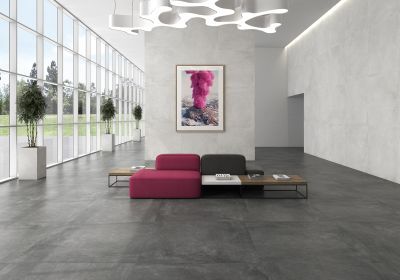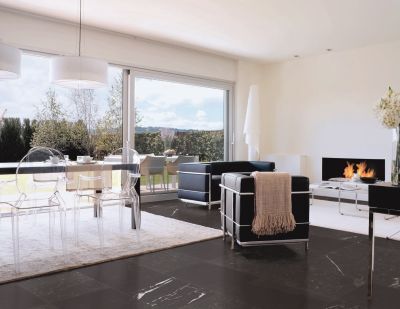Floor tiles guide
content
1. The floor tile: from ancient building materials to popular trendsetters
2. Why are floor tiles more popular today than ever?
3. What should you watch out for when buying floor tiles?
a) Types of floor tiles
b) Floor tiles - colors, formats, combinations
c) The appropriate abrasion group
d) Non-slip classes / anti-slip classes
e) How many floor tiles do you need for your project?
4. Lay the floor tiles - step by step
a) Prepare the surface
b) Determine the laying technique
c) Apply tile adhesive
d) gluing the floor tiles
e) Cut floor tiles
f) Grout and clean floor tiles
g) sealing the wall joints
5. Floor tiles - cleaning and care
6. Floor tiles profile - there are these types
a) Earthenware tiles
b) stoneware tiles
c) porcelain stoneware tiles
d) natural stone tiles (quartzite tiles, marble tiles, granite tiles)
e) Mosaic tiles
1. The floor tile: from ancient building materials to popular trendsetters
Already around 2000 BC BC adorned the floors of the houses in the Orient. The Romans brought ceramic flooring across the Alps before it was forgotten for many centuries. Only with the beginning of industrial production around 1850 did the floor tile gain growing acceptance in Germany.
After all, today's floor tile offers countless design options. It tastefully covers the floors of bathrooms, hallways, kitchens and business premises. Even in living rooms, the versatile covering creates cosiness and increasingly replaces the previous carpets. Outside, tiles on terraces and paths help create an attractive “green living room” that invites you and your guests to relax and unwind.
2. Why are floor tiles more popular today than ever?
There are many valuable properties that make this flooring so popular. In addition to the wide range of possible uses, there are no limits to the design. In addition, specialist companies now offer a huge selection of different variants. At the same time, floor tiles are extremely robust and extremely easy to care for. If you choose this flooring, you will be happy with it for many decades. That is exactly why a well-thought-out selection, professional laying and the right care are particularly important.
In order for you to enjoy your floor tiles for a long time and to be able to fully exploit all the advantages, we present some valuable tips for buying, laying and cleaning below. You will also learn more about the different types of floor tiles so that you can be sure of finding the flooring that suits you.
3. What should you watch out for when buying floor tiles?
a) Types of floor tiles
Today, floor tiles are manufactured using a wide variety of materials. The largest segment is made up of ceramic tiles. These include stoneware tiles, porcelain stoneware tiles and earthenware tiles. The most significant difference lies in the water absorption capacity. Finally, only floor tiles with the lowest possible water absorption capacity are suitable for outdoor use, as is the case with porcelain stoneware with its special density. This property results in a frost-proof floor tile in which no water can freeze and frost damage can occur. Detailed information on the different types of floor tiles can be found under point 6.
b) Floor tiles - colors, formats, combinations
Floor tile manufacturers have extensive know-how and modern techniques for coloring the materials. This does not apply to natural stone, which is only available in its natural design. Otherwise, it does not matter whether it is plain, marbled or patterned - the choice of colors knows no limits. Even the choice between concrete, natural stone or wood look is part of the standard of innovative specialist companies. By the way, you can also choose between a polished, polished or matt finish.
Decors, combinations, mosaics or large formats - each variant has a different effect on the room. Large-format floor tiles, for example, give rooms a spacious look and can also be quickly installed. If you want to set small accents, combine different formats and decors or let elements made of mosaic act as an eye-catcher.
Ultimately, it will always be personal taste that decides between timeless and reserved design and current fashion trends. However, awareness must always be present that a decision will be made here for many decades. Anyone who thinks about combinations and suitable formats is always on the safe side with professional advice, which specialist companies also offer via online shops.
c) The appropriate abrasion group
As soon as you want to equip your rooms with new tiles, the resilience of the new flooring becomes an important issue. Anyone who makes the appropriate selection here is spared rapid abrasion due to high running frequency. For this purpose, the floor tiles are divided into five wear groups (I - V). The higher the rating, the more resistant the floor is to abrasion. But which abrasion group is suitable for which room?
In the private sector, floor tiles up to wear group IV are completely sufficient. In bathrooms, bedrooms and living rooms, specialist companies generally consider abrasion groups I or II to be completely sufficient. Abrasion group III may be reserved for more frequented rooms, while ideally the kitchen will be equipped with floor tiles of abrasion group IV. Below you will find a summary of the ideal use of the different wear groups:
- Abrasion group I: bedrooms, bathrooms, guest toilets
- Abrasion group II: living rooms with low running frequency
- Abrasion group III: living rooms with medium walking frequency, hotel rooms
- Abrasion group IV: all rooms that are subject to greater wear due to regular use with street
- shoes, such as kitchens, entrance areas, terraces, as well as offices, hospitals, authorities and schools
- Abrasion group V: mainly used in commercial and public areas such as restaurants, banks, butchers and hairdressers
d) Non-slip classes / anti-slip classes
In the commercial sector, the anti-slip classes and anti-slip classes are extremely important for compliance with the safety standards. After all, the non-slip classes divide the floor tiles step by step according to their static friction from low to very large. The following recommendation applies to private households: Floor tiles of slip resistance class R9 or higher are generally sufficient. The slip resistance class is divided into categories A (dry floors), B (wet floors) and C (swimming pools). The bottom line is that the R9A class is suitable, for example, for normally dry floors such as living rooms or bedrooms, while the R9B class is recommended for bathrooms and other wet rooms.
e) How many floor tiles do you need for your project?
If you calculate the total area of the floor and calculate a good 10% for the waste, you get a realistic value. By the way, it is always advisable to order one more package. This means that you are well equipped for subsequent repair work.
4. Lay the floor tiles - step by step
a) Prepare the surface
Materials:
- Leveling compound (leveling compound or leveling compound)
- Primer or deep primer
- Waterproofing coating for wet rooms
Tools:
- Mortar bucket and drill with stirring attachment for mixing the leveling compound
- Painter's puff
To lay the floor tiles, you need a clean, level, dry and stable surface. The rule of thumb here is: "The bigger the format, the flatter the ground." Observe the maximum layer thickness specified in the processing instructions. As soon as the drying time specified by the manufacturer has ended, the primer or deep primer can be applied. Use Tiefengrund on particularly absorbent substrates such as cement screed. Non-absorbent surfaces such as concrete or very smooth surfaces are treated with a primer. It is then recommended to apply a sealing coat in wet rooms.
b) Determine the laying technique
Tools:
- Yardstick
- Marking pen
- Guidelines for determining the center of the room
The parallel installation is ideal for beginners. You start in the middle of the room and work from the inside out. The floor tiles only have to be cut at the edges. It is advisable to first lay out the first two rows of tiles without a tile adhesive along the longer line as a test.
The diagonal laying is somewhat more demanding. After determining the center of the room, the tiles are gradually laid from the center along the parallels and diagonals, so that wonderful accents can be created, especially in square rooms. In addition, existing crooked walls are less visually important due to this type of installation.
c) Apply tile adhesive
Materials:
tile glue
Tools:
- Mortar bucket
- Drill with stirring attachment for lump-free mixing
- Trowel or trowel for application
Toothed spatula with the following serration for combing the tile sink
- decide depending on the tile size:
- up to 100 mm edge length 6 mm
- up to 200 mm edge length 8 mm
- up to 300 mm edge length 10 mm
- up to 300 mm edge length 12 mm
The surface is dry and the laying pattern is there - you can now mix the tile adhesive with water according to the manufacturer's instructions. Apply the mass evenly on the surface with a trowel 5 to 10 mm after the ripening time. Then slide over it with a notched trowel. Work in small sections of a maximum of 1.5 m2. If the back of the tile is strongly profiled, it is advisable to apply tile adhesive here, to comb it and to lay it across the grooves running on the floor.
d) gluing the floor tiles
Tools:
- Rubber mallet
- Tile crosses in a suitable size
- Tile tracks
- Wooden wedge
Press the floor tile into the freshly applied adhesive and tap the tile lightly with a rubber hammer. Occasionally, there may be slight color differences between the individual packaging units. Therefore, use tiles from different containers right from the start. Always raise a floor tile during installation to check whether it is at least 80% covered with adhesive (100% for natural stone tiles). Regularly check the correct position of your floor tiles. Once the adhesive has tightened, corrections are no longer possible. When laying, take a joint width of at least 2 mm into account or follow the manufacturer's instructions. Use appropriately sized tile crosses. Also plan expansion joints for the walls and transitions. Use tile tracks as a design tool and above all to get clean corners and edges. Use a wooden wedge to remove any excess tile adhesive from the joints before the adhesive has hardened.
e) Cut floor tiles
Tools:
- Tile cutter
- Tile punch pliers or alternatively drill with hole milling attachment
You get the best results with a special tile cutter. The tiles are scratched on the surface and then broken over the broken edge. For round recesses, such as drainpipes, it is best to use a hole punch to cut out the opening in several steps.
f) Grout and clean floor tiles
Materials:
grout suitable for the adhesive in the appropriate shade
Tools:
- rubber gloves
- Mortar bucket
- Drill with stirring attachment for lump-free mixing
- Trowel or trowel
- Tile washboard or rubber wiper
- Joint rubber
- Sponge for cleaning
At least 24 hours should elapse between gluing the last floor tile and grouting. This is how long the tile adhesive usually takes to harden. Please also note the manufacturer's information. Then mix the grout according to the instructions in the processing instructions. Protect your hands with rubber gloves and work step-by-step on smaller surfaces when applying: Put part of the mass on the floor and spread it diagonally as far as possible with the joint rubber. Use a tile washboard or alternatively a rubber squeegee to carefully remove the mortar remaining on the floor tiles.
As soon as the grout has a matt appearance, it has dried. Follow the manufacturer's instructions here too. Now you can start cleaning the floor tiles. Use a damp sponge to remove any remaining mortar. If the cleaning is too wet, there is a risk of washing out the joints that have not yet completely dried out. Then polish the floor tiles with a dry cloth. You still notice a slight mortar veil? Wait at least 14 days before cleaning your new floor with a special remover.
g) sealing the wall joints
Materials:
- primer
- silicone
Tools:
- Masking tape
- Cartridges for silicone
- Joint smoothing machine
By laying the tiles, joints are created between the walls and floor tiles, which need to be sealed with silicone instead of the usual grout (for natural stones with special natural stone silicone). The same applies to the joints between base tiles and floor tiles. To do this, mask off the wall and tile area next to the joints with masking tape and remove any remaining adhesive from the joints. If the surface is very absorbent, we recommend pretreatment with a primer. Then you can distribute the silicone from the cartridge evenly into the joints. Then wait a few minutes before smoothing the mass with a joint smoother and a little washing-up water. Now all you have to do is carefully peel off the tape and your new floor tile covering is ready.
5. Floor tiles - cleaning and care
Hardly any floor covering is as easy to maintain as floor tiles. For normal cleaning, a soft broom or a vacuum cleaner with a brush attachment is sufficient. If there is visible dirt, a microfiber cloth or a floor wiper with a little water and neutral detergent will do. Floor tiles prefer minimalist cleaning and care. The Federal Association of Ceramic Tiles, by the way, even advises against cleaning products containing care, since with regular use a stubborn film forms on the surface, which affects the appearance and slip resistance.
If more effective cleaning is required at certain points, you should only use special cleaning agents from specialist dealers.
6. Floor tiles profile - there are these types
a) Earthenware tiles
- ceramic tile
- Quality in one or two fire processes
- absorbs a relatively large amount of water
- less suitable for outdoor use
b) stoneware tiles
- ceramic tile
- low water absorption
- frost-resistant
- very robust due to high density
- unglazed and glazed surfaces available
- suitable for indoor and outdoor use
c) porcelain stoneware tiles
- ceramic tile
- extremely low water absorption
- completely frost-resistant
- color design by adding colored ceramic powder
- printed optics possible with glazed surface
- absolutely robust due to very high density
- suitable for indoor and outdoor use
d) natural stone tiles (quartzite tiles, marble tiles, granite tiles)
- noble and natural design in the colors of nature
- outstanding robustness due to extraordinary hardness
- high durability
- very sustainable flooring
- very large formats possible (e.g. 1000 mm x 3000 mm)
- suitable for indoor and outdoor use
e) Mosaic tiles
- Glass mosaic, natural stone mosaic, ceramic mosaic
- Combinations of several materials possible
- smallest stones
- perfect for setting homely accents
- anti-slip effect as flooring
- suitable for indoor and outdoor use depending on the material
In addition, specialist companies now offer a huge selection of all conceivable formats, surfaces and optics. In conclusion, floor tiles demonstrate just as many design options as practical advantages. All that remains for us to do is wish you a lot of fun designing your own flooring. You will definitely find the right floor tiles for this.



